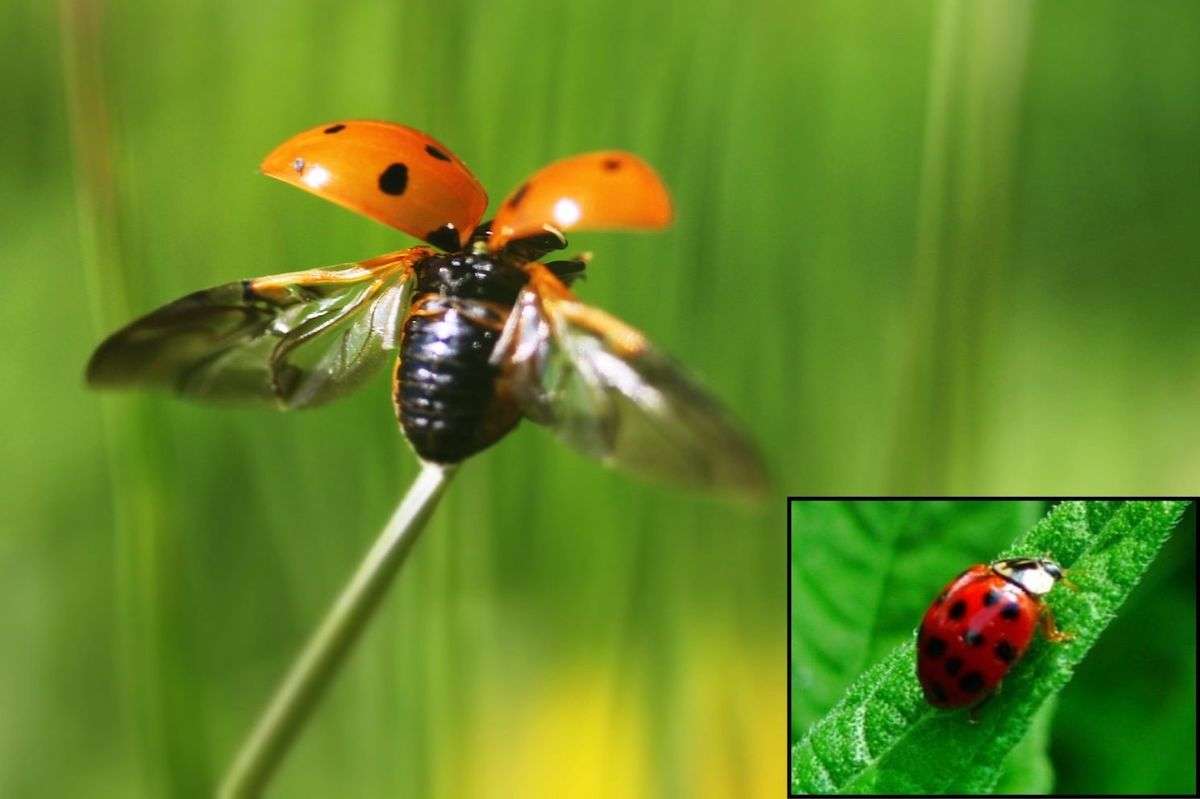Out In The Woods
- July 5th 2024
- Out in the Woods

Lady beetles have hardened forewings that protect their flying wings during walking and open up for flight. Inset: Lady beetle foraging for aphids, mites, small insect and other lady beetle larvae.
Photos: Internet
Lady Beetles
By Kevin McKeon, Maine Master Naturalist
The name “ladybug” was coined by European farmers who prayed to the Virgin Mary when pests began eating their crops. After ladybugs came and wiped out the invading insects, the farmers named them “Beetle of Our Lady”. This eventually was shortened to “Lady beetle” and “Ladybug.” Actually, they are beetles, members of the 285-million-year-old Coleoptera order of insects, the largest order of animals on Earth with about 400,000 species comprising about 40% of all insects and about 25% of all animal species! Bugs are similar to beetles, but they’re a completely different type of insect; the main difference is that beetles have chewing mouthparts, where bugs have a piercing beak called a rostrum which acts like a hypodermic needle which they use to suck juices from plants or animals. Beetles are the only insects with hardened forewings that cover and protect their flying wings. Watch as they hatch, and fly Notice that they’re not “spotted” until their forewings harden after emerging from their cocoon.
The multi-color Asian ladybugs, a member of the 190-million-year-old beetle family of about 6,000 species, are the visitors we see seeking shelter in people’s houses in September. Their color varies from pale yellow to a bright red orange, with varying degrees of spot brilliance and spot size. A fully spotted beetle will have 10 black spots.
Introduced as a biological control agent in various states beginning in 1916, they didn’t seem to have become established. Then, in 1988, specimens were found in Louisiana, probably from Asian cargo shipping to New Orleans. Since the early 1990s, this exotic lady beetle has proliferated and moved rapidly across much of the United States east of the Mississippi River, along the West Coast, and into eastern Canada.
Alpine hikers will at times find them by the thousands on sunny, rocky outcrops as they seek warm shelter. Homeowners find them a nuisance when they sometimes invade houses and buildings in large numbers in the fall, appearing again on warm, sunny days in February and March. But they do not breed, lay eggs, or feed inside the home, and are not structurally-damaging. If agitated or squashed, however, the beetles may exhibit a defensive reaction known as “reflex bleeding,” in which a yellow fluid with an unpleasant odor is released from leg joints. This reaction helps protect beetles from predators, such a birds. But in the home, the fluid may stain walls and fabrics. Some of us simply let them be if autumn entry occurs. Others brush them into a shoebox, store it away, and release them in the spring, when they will mate.
Gardeners and agriculturalists consider lady beetles to be beneficial, preying on many different soft-bodied insect pests on a variety of crops. An adult beetle is capable of eating 90 to 270 aphids per day, and each larva can consume 600 to 1,200 aphids during its development!
Watch this life cycle video Cannibalism is quite common with many insects. The 10-15, yellowish, tiny eggs, laid under leaves, generally hatch in three to five days. Looking like tiny alligators, the larvae are hungry, feeding for about two weeks on aphids, scale insects, and other soft-bodied invertebrates, gobbling up 600 to 1,200 aphids during this life stage. The chrysalis stage lasts about five to six days, looking like a tiny shrimp attached to a leaf. After emergence, adults can live as long as two to three years eating 90 to 270 aphids per day! Another common beetle is our firefly, another story for later.






